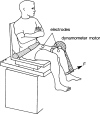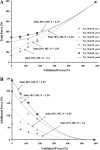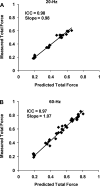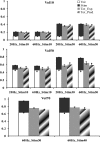A phenomenological model that predicts forces generated when electrical stimulation is superimposed on submaximal volitional contractions
- PMID: 20299613
- PMCID: PMC2886680
- DOI: 10.1152/japplphysiol.01231.2009
A phenomenological model that predicts forces generated when electrical stimulation is superimposed on submaximal volitional contractions
Abstract
Superimposition of electrical stimulation during voluntary contractions is used to produce functional movements in individuals with central nervous system impairment, to evaluate the ability to activate a muscle, to characterize the nature of fatigue, and to improve muscle strength during postsurgical rehabilitation. Currently, the manner in which voluntary contractions and electrically elicited forces summate is not well understood. The objective of the present study is to develop a model that predicts the forces obtained when electrical stimulation is superimposed on a volitional contraction. Quadriceps femoris muscles of 12 able-bodied subjects were tested. Our results showed that the total force produced when electrical stimulation was superimposed during a volitional contraction could be modeled by the equation T=V+S[(MaxForce-V)/MaxForce]N, where T is the total force produced, V is the force in response to volitional contraction alone, S is the force response to the electrical stimulation alone, MaxForce is the maximum force-generating ability of the muscle, and N is a parameter that we posit depends on the differences in the motor unit recruitment order and firing rates between volitional and electrically elicited contractions. In addition, our results showed that the model predicted accurately (intraclass correlation coefficient>or=0.97) the total force in response to a wide range of stimulation intensities and frequencies superimposed on a wide range of volitional contraction levels. Thus the model will be helpful to clinicians and scientists to predict the amount of stimulation needed to produce the targeted force levels in individuals with partial paralysis.
Figures






References
-
- Barnett S, Cooney K, Johnston R. Electrically elicited quadriceps femoris muscle torque as a function of various electrode placements. J Clin Electrophysiol 3: 5–8, 1991
-
- Binder-Macleod SA, Halden EE, Jungles KA. Effects of stimulation intensity on the physiological responses of human motor units. Med Sci Sports Exerc 27: 556–565, 1995 - PubMed
-
- Binder-Macleod SA, Lee SC, Baadte SA. Reduction of the fatigue-induced force decline in human skeletal muscle by optimized stimulation trains. Arch Phys Med Rehabil 78: 1129–1137, 1997 - PubMed
-
- Chae J. Neuromuscular electrical stimulation for motor relearning in hemiparesis. Phys Med Rehabil Clin N Am 14, Suppl 1: S93–S109, 2003 - PubMed
-
- de Kroon JR, van der Lee JH, IJzerman MJ, Lankhorst GJ. Therapeutic electrical stimulation to improve motor control and functional abilities of the upper extremity after stroke: a systematic review. Clin Rehabil 16: 350–360, 2002 - PubMed
Publication types
MeSH terms
Grants and funding
LinkOut - more resources
Full Text Sources

